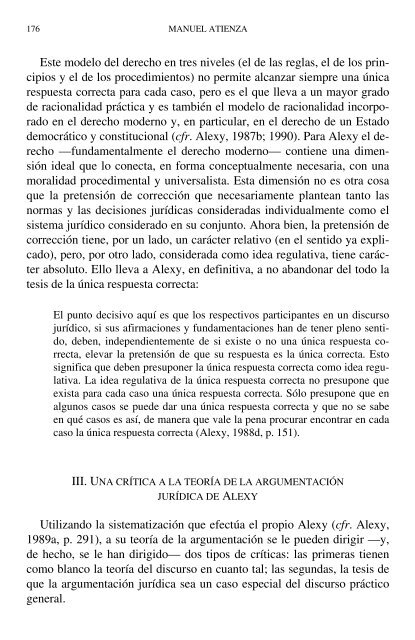LAS RAZONES DEL DERECHO Teo rías de la ar gu men ta ción ju rí di ca
You also want an ePaper? Increase the reach of your titles
YUMPU automatically turns print PDFs into web optimized ePapers that Google loves.
176 MANUEL ATIENZA<br />
Este mo<strong>de</strong>lo <strong>de</strong>l <strong>de</strong>recho en tres niveles (el <strong>de</strong> <strong>la</strong>s reg<strong>la</strong>s, el <strong>de</strong> los principios<br />
y el <strong>de</strong> los proce<strong>di</strong>mientos) no permite al<strong>ca</strong>nz<strong>ar</strong> siempre una úni<strong>ca</strong><br />
respues<strong>ta</strong> correc<strong>ta</strong> p<strong>ar</strong>a <strong>ca</strong>da <strong>ca</strong>so, pero es el que lleva a un mayor grado<br />
<strong>de</strong> racionalidad prácti<strong>ca</strong> y es <strong>ta</strong>mbién el mo<strong>de</strong>lo <strong>de</strong> racionalidad incorporado<br />
en el <strong>de</strong>recho mo<strong>de</strong>rno y, en p<strong>ar</strong>ticu<strong>la</strong>r, en el <strong>de</strong>recho <strong>de</strong> un Es<strong>ta</strong>do<br />
<strong>de</strong>mocrático y constitucional (cfr. Alexy, 1987b; 1990). P<strong>ar</strong>a Alexy el <strong>de</strong>recho<br />
—funda<strong>men</strong><strong>ta</strong>l<strong>men</strong>te el <strong>de</strong>recho mo<strong>de</strong>rno— contiene una <strong>di</strong><strong>men</strong>sión<br />
i<strong>de</strong>al que lo conec<strong>ta</strong>, en forma conceptual<strong>men</strong>te neces<strong>ar</strong>ia, con una<br />
moralidad proce<strong>di</strong><strong>men</strong><strong>ta</strong>l y universalis<strong>ta</strong>. Es<strong>ta</strong> <strong>di</strong><strong>men</strong>sión no es otra cosa<br />
que <strong>la</strong> pretensión <strong>de</strong> correc<strong>ción</strong> que neces<strong>ar</strong>ia<strong>men</strong>te p<strong>la</strong>ntean <strong>ta</strong>nto <strong>la</strong>s<br />
normas y <strong>la</strong>s <strong>de</strong>cisiones <strong>ju</strong><strong>rí</strong><strong>di</strong><strong>ca</strong>s consi<strong>de</strong>radas in<strong>di</strong>vidual<strong>men</strong>te como el<br />
sistema <strong>ju</strong><strong>rí</strong><strong>di</strong>co consi<strong>de</strong>rado en su con<strong>ju</strong>nto. Ahora bien, <strong>la</strong> pretensión <strong>de</strong><br />
correc<strong>ción</strong> tiene, por un <strong>la</strong>do, un c<strong>ar</strong>ácter re<strong>la</strong>tivo (en el sentido ya expli<strong>ca</strong>do),<br />
pero, por otro <strong>la</strong>do, consi<strong>de</strong>rada como i<strong>de</strong>a re<strong>gu</strong><strong>la</strong>tiva, tiene c<strong>ar</strong>ácter<br />
absoluto. Ello lleva a Alexy, en <strong>de</strong>finitiva, a no abandon<strong>ar</strong> <strong>de</strong>l todo <strong>la</strong><br />
tesis <strong>de</strong> <strong>la</strong> úni<strong>ca</strong> respues<strong>ta</strong> correc<strong>ta</strong>:<br />
El punto <strong>de</strong>cisivo aquí es que los respectivos p<strong>ar</strong>ticipantes en un <strong>di</strong>scurso<br />
<strong>ju</strong><strong>rí</strong><strong>di</strong>co, si sus afirmaciones y funda<strong>men</strong><strong>ta</strong>ciones han <strong>de</strong> tener pleno sentido,<br />
<strong>de</strong>ben, in<strong>de</strong>pen<strong>di</strong>ente<strong>men</strong>te <strong>de</strong> si existe o no una úni<strong>ca</strong> respues<strong>ta</strong> correc<strong>ta</strong>,<br />
elev<strong>ar</strong> <strong>la</strong> pretensión <strong>de</strong> que su respues<strong>ta</strong> es <strong>la</strong> úni<strong>ca</strong> correc<strong>ta</strong>. Esto<br />
signifi<strong>ca</strong> que <strong>de</strong>ben presuponer <strong>la</strong> úni<strong>ca</strong> respues<strong>ta</strong> correc<strong>ta</strong> como i<strong>de</strong>a re<strong>gu</strong><strong>la</strong>tiva.<br />
La i<strong>de</strong>a re<strong>gu</strong><strong>la</strong>tiva <strong>de</strong> <strong>la</strong> úni<strong>ca</strong> respues<strong>ta</strong> correc<strong>ta</strong> no presupone que<br />
exis<strong>ta</strong> p<strong>ar</strong>a <strong>ca</strong>da <strong>ca</strong>so una úni<strong>ca</strong> respues<strong>ta</strong> correc<strong>ta</strong>. Sólo presupone que en<br />
al<strong>gu</strong>nos <strong>ca</strong>sos se pue<strong>de</strong> d<strong>ar</strong> una úni<strong>ca</strong> respues<strong>ta</strong> correc<strong>ta</strong> y que no se sabe<br />
en qué <strong>ca</strong>sos es así, <strong>de</strong> manera que vale <strong>la</strong> pena procur<strong>ar</strong> encontr<strong>ar</strong> en <strong>ca</strong>da<br />
<strong>ca</strong>so <strong>la</strong> úni<strong>ca</strong> respues<strong>ta</strong> correc<strong>ta</strong> (Alexy, 1988d, p. 151).<br />
III. UNA CRÍTICA A LA TEORÍA DE LA ARGUMENTACIÓN<br />
JURÍDICA DE ALEXY<br />
Utilizando <strong>la</strong> sistematiza<strong>ción</strong> que efectúa el propio Alexy (cfr. Alexy,<br />
1989a, p. 291), a su teo<strong>rí</strong>a <strong>de</strong> <strong>la</strong> <strong>ar</strong><strong>gu</strong><strong>men</strong><strong>ta</strong><strong>ción</strong> se le pue<strong>de</strong>n <strong>di</strong>rigir —y,<br />
<strong>de</strong> hecho, se le han <strong>di</strong>rigido— dos tipos <strong>de</strong> c<strong>rí</strong>ti<strong>ca</strong>s: <strong>la</strong>s primeras tienen<br />
como b<strong>la</strong>nco <strong>la</strong> teo<strong>rí</strong>a <strong>de</strong>l <strong>di</strong>scurso en cuanto <strong>ta</strong>l; <strong>la</strong>s se<strong>gu</strong>ndas, <strong>la</strong> tesis <strong>de</strong><br />
que <strong>la</strong> <strong>ar</strong><strong>gu</strong><strong>men</strong><strong>ta</strong><strong>ción</strong> <strong>ju</strong><strong>rí</strong><strong>di</strong><strong>ca</strong> sea un <strong>ca</strong>so especial <strong>de</strong>l <strong>di</strong>scurso práctico<br />
general.



